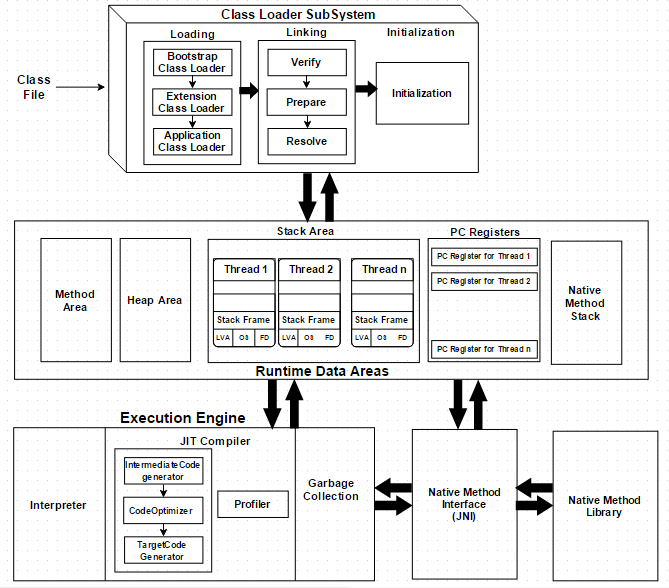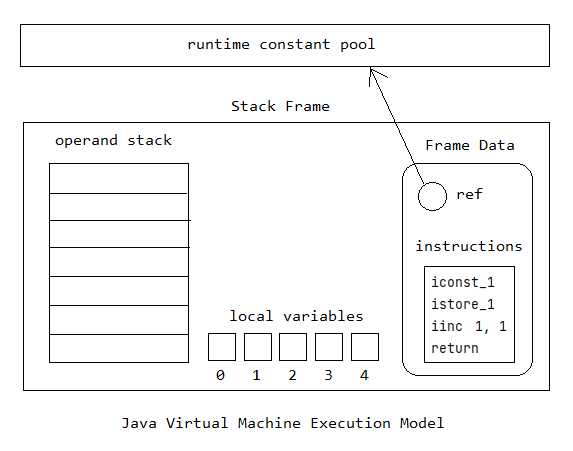JVM 的组成部分
从 JVM 组成的角度来说,它由 Class Loader SubSystem、Runtime Data Areas 和 Execution Engine 三个部分组成:
- 类加载子系统(Class Loader SubSystem),负责加载具体的
.class文件。 - 运行时数据区(Runtime Data Areas),主要负责为执行引擎(Execution Engine)提供“空间维度”的支持, 为类(Class)、对象实例(object instance)、局部变量(local variable)提供存储空间。
- 执行引擎(Execution Engine),主要负责方法体里的 instruction 内容,它是 JVM 的核心部分。

在 JVM 当中,数据类型分成 primitive type 和 reference type 两种,那么 ClassLoader 负责加载哪些类型呢?
- 对于 primitive type 是 JVM 内置的类型,不需要 ClassLoader 加载。
- 对于 reference type 来说,它又分成类(class types)、接口(interface types)和数组(array types)三种子类型。
- ClassLoader 只负责加载类(class types)和接口(interface types)。
- JVM 内部会帮助我们创建数组(array types)。
JVM Execution Engine
At the core of any Java Virtual Machine implementation is its execution engine.
JVM 文档:指令集
在The Java Virtual Machine Specification中,它没有明确的提到 Execution Engine 的内容:打开 JVM 文档的每一章内容,搜索“execution engine”,会发现没有相关内容。
那么,这是不是意味着 JVM 文档与 Execution Engine 两者之间没有关系呢?其实,两者之间是有关系的。
可能是 JVM 文档描述的比较含蓄,它执行引擎(Execution Engine)的描述是通过指令集(Instruction Set)来体现的。
In the Java Virtual Machine specification, the behavior of the execution engine is defined in terms of an instruction set.
执行引擎:三种解读
The term “execution engine” can also be used in any of three senses: an abstract specification, a concrete implementation, or a runtime instance.
- The abstract specification defines the behavior of an execution engine in terms of the instruction set.
- Concrete implementations, which may use a variety of techniques, are either software, hardware, or a combination of both.
- A runtime instance of an execution engine is a thread.
Each thread of a running Java application is a distinct instance of the virtual machine’s execution engine. From the beginning of its lifetime to the end, a thread is either executing bytecodes or native methods. A thread may execute bytecodes directly, by interpreting or executing natively in silicon, or indirectly, by just-in-time compiling and executing the resulting native code.
A Java Virtual Machine implementation may use other threads invisible to the running application, such as a thread that performs garbage collection. Such threads need not be “instances” of the implementation’s execution engine. All threads that belong to the running application, however, are execution engines in action.
Runtime Data Areas: JVM Stack
在现实生活当中,我们生活在一个三维的空间,在这个空间维度里,可以确定一个事物的具体位置;同时,也有一个时间维度,随着时间的流逝,这个事物的状态也会发生变化。简单来说,对于一个具体事物,空间维度上就是看它占据一个什么位置,时间维度上就看它如何发生变化。 接下来,我们把“空间维度”和“时间维度”的视角带入到 JVM 当中。
在 JVM 当中,是怎么体现“空间维度”视角和“时间维度”两个视角的呢?
- 时间维度。上面谈到执行引擎(Execution Engine),一条一条的执行 instruction 的内容,会引起相应事物的状态发生变化,这就是“时间维度”的视角。
- 空间维度。接下来要讲的 JVM Stack 和 Stack Frame,它们都是运行时数据区(Runtime Data Areas)具体的内存空间分配,用于存储相应的数据,这就是“空间维度”视角。

thread 对应于 JVM Stack
上面提到,线程(thread)是执行引擎(Execution Engine)的运行实例,那么线程(thread)就是一个“时间维度”的视角。 JVM Stack 是运行时数据区(Runtime Data Areas)的一部分,是“空间维度”的视角。 两者之间是什么样的关系呢?
Each Java Virtual Machine thread has a private Java Virtual Machine stack, created at the same time as the thread.
那么,对于线程(thread)来说,它就同时具有“时间维度”(Execution Engine)和“空间维度”(JVM Stack)。
A Java Virtual Machine stack stores frames.
method 对应于 Stack Frame
接着,我们如何看待方法(method)呢?或者说方法(method)是什么呢? 方法(method),是一组 instruction 内容的有序集合; 而 instruction 的执行,就对应着时间的流逝,所以方法(method)也可以理解成一个“时间片段”。
那么,线程(thread)和方法(method)是什么关系呢? 线程(thread),从本质上来说,就是不同方法(method)之间的调用。 所以,线程(thread)是更大的“时间片段”,而方法(method)是较小的“时间片段”。
上面描述,体现方法(method)是在“时间维度”的考量,在“空间维度”上有哪些体现呢? 在“空间维度”上,就体现为 Stack Frame。
- A new frame is created each time a method is invoked.
- A frame is destroyed when its method invocation completes, whether that completion is normal or abrupt (it throws an uncaught exception).
接下来,介绍 current frame、current method 和 current class 三个概念。
Only one frame, the frame for the executing method, is active at any point in a given thread of control. This frame is referred to as the current frame, and its method is known as the current method. The class in which the current method is defined is the current class.
一个方法会调用另外一个方法,另一个方法也有执行结束的时候。那么,current frame 是如何变换的呢?
- A frame ceases to be current if its method invokes another method or if its method completes.
- When a method is invoked, a new frame is created and becomes current when control transfers to the new method.
- On method return, the current frame passes back the result of its method invocation, if any, to the previous frame.
- The current frame is then discarded as the previous frame becomes the current one.
Runtime Data Areas: Stack Frame
当一个具体的 .class 加载到 JVM 当中之后,方法的执行会对应于 JVM 当中一个 Stack Frame 内存空间。
Stack Frame 的内部结构
对于 Stack Frame 内存空间,主要分成三个子区域:
- 第一个子区域,operand stack,是一个栈结构,遵循后进先出(LIFO)的原则;它的大小是由
Code属性中的max_stack来决定的。 - 第二个子区域,local variables,是一个数组结构,通过索引值来获取和设置里面的数据,其索引值是从
0开始;它的大小是由Code属性中的max_locals来决定的。 - 第三个子区域,Frame Data,它用来存储与当前方法相关的数据。例如,一个指向 runtime constant pool 的引用、出现异常时的处理逻辑(exception table)。
在 Frame Data 当中,我们也列出了其中两个重要数据信息:
- 第一个数据,
instructions,它表示指令集合,是由Code属性中的code[]解析之后的结果。(准确的来说,这里是不对的,instructions 可能是位于 Method Area 当中。我们为了看起来方便,把它放到了这里。) - 第二个数据,
ref,它是一个指向 runtime constant pool 的引用。这个 runtime constant pool 是由具体.class文件中的 constant pool 解析之后的结果。

Code_attribute {
u2 attribute_name_index;
u4 attribute_length;
u2 max_stack;
u2 max_locals;
u4 code_length;
u1 code[code_length];
u2 exception_table_length;
{ u2 start_pc;
u2 end_pc;
u2 handler_pc;
u2 catch_type;
} exception_table[exception_table_length];
u2 attributes_count;
attribute_info attributes[attributes_count];
}
Stack Frame 内的数据类型
在这里,我们要区分开两个概念:存储时的类型 和 运行时的类型。
将一个具体 .class 文件加载进 JVM 当中,存放数据的地方有两个主要区域:堆(Heap Area)和栈(Stack Area)。
- 在堆(Heap Area)上,存放的就是 Actual type,就是“存储时的类型”。例如,
byte类型就是占用 1 个 byte,int类型就是占用 4 个 byte。 - 在栈(Stack Area)上,更确切的说,就是 Stack Frame 当中的 operand stack 和 local variables 区域,存放的就是 Computational type。
这个时候,类型就发生了变化,
boolean、byte、char、short都会被转换成int类型来进行计算。
在方法执行的时候,或者说方法里的 instruction 在执行的时候,需要将相关的数据加载到 Stack Frame 里; 更进一步的说,就是将数据加载到 operand stack 和 local variables 两个子区域当中。

当数据加载到 operand stack 和 local variables 当中时,需要注意三点:
- 第一点,
boolean,byte,short,char, orint,这几种类型,在 local variable 和 operand stack 当中,都是作为int类型进行处理。 - 第二点,
int、float和reference类型,在 local variable 和 operand stack 当中占用 1 个位置 - 第三点,
long和double类型,在 local variable 和 operand stack 当中占用 2 个位置
举个例子,在一个类当中,有一个 byte 类型的字段。
将该类加载进 JVM 当中,然后创建该类的对象实例,那么该对象实例是存储在堆(Heap Area)上的,其中的字段就是 byte 类型。
当程序运行过程中,会使用到该对象的字段,这个时候就要将 byte 类型的值转换成 int 类型进行计算;
计算完成之后,需要将值存储到该对象的字段当中,这个时候就会将 int 类型再转换成 byte 类型进行存储。
另外,对于 Category 为 1 的类型,在 operand stack 和 local variables 当中占用 1 个 slot 的位置;
对于对于 Category 为 2 的类型,在 operand stack 和 local variables 当中占用 2 个 slot 的位置。
下表的内容是来自于Java Virtual Machine Specification的Table 2.11.1-B. Actual and Computational types in the Java Virtual Machine部分。
| Actual type | Computational type | Category |
|---|---|---|
| boolean | int | 1 |
| byte | int | 1 |
| char | int | 1 |
| short | int | 1 |
| int | int | 1 |
| float | float | 1 |
| reference | reference | 1 |
| long | long | 2 |
| double | double | 2 |
在2.11.1. Types and the Java Virtual Machine谈到:
most operations on values of actual types boolean, byte, char, and short are correctly performed
by instructions operating on values of computational type int.
对于 local variable 是这样描述的:(内容来自于2.6.1. Local Variables)
- A single local variable can hold a value of type
boolean,byte,char,short,int,float,reference, orreturnAddress. - A pair of local variables can hold a value of type
longordouble.
对于 operand stack 是这样描述的:(内容来自于2.6.2. Operand Stacks)
- Each entry on the operand stack can hold a value of any Java Virtual Machine type, including a value of type
longor typedouble. - At any point in time, an operand stack has an associated depth, where a value of type
longordoublecontributes two units to the depth and a value of any other type contributes one unit.
总结
本文内容总结如下:
- 第一点,Execution Engine 是 JVM 的核心;JVM 文档中的 Instruction Set 就是对 Execution Engine 的行为描述;线程就是 Execution Engine 的运行实例。
- 第二点,线程所对应的内存空间是 JVM Stack,方法所对应的内存空间是 Stack Frame。
- 第三点,在 Stack Frame 当中,分成 local variable、operand stack 和 frame data 三个子区域; 在 local variable 和 operand stack 中,要注意数据的计算类型和占用的空间大小。
